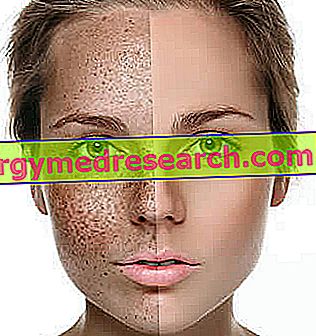
Freckles
Determined by genetic factors, freckles are hyperchromies in the form of a small pigmented spot, dark in color and circular in shape.

Following repeated irritative stimuli or degenerative phenomena related to old age, freckles can present morphological changes (increase in volume, surface irregularity).
The freckles

Solar lentigo

Lentigo senili

Melasma
Melasma, or chloasma gravidarum, is linked to an irregular and intense accumulation of melanin, not accompanied by proliferation of melanocytes, but by an overproduction of the pigment itself.

However, three main melasma distribution areas can be recognized:
- Facial center area, which includes nose, forehead, cheeks, upper lip and chin
- Cheeks and nose
- Mandibular area (less common)
Melasma is also called chloasma gravidarum because it appears very often in pregnancy or when taking the contraceptive pill. It affects brown women and dark-skinned women with greater incidence. The causes of this phenomenon are not yet clearly defined, but the action of estrogen and sun exposure play an important role. The appearance of the spots, in fact, seems to be correlated to the hormonal levels, in particular to 17-β estradiol, responsible for a significant increase in tyrosinase activity. Melasma is also more widespread in the summer months than in the winter months, demonstrating that sun exposure is one of the main causes responsible for the appearance of this phenomenon. A genetic predisposition, stress, the use of some drugs, ovulation disorders and allergic reactions due to the use of cosmetics can help trigger or worsen this pigmentation disorder. Melasma can improve with lightening creams, peelings and lasers, but sometimes it tends to reform itself for several years after the first event.
Freckles from "tanning bed"
They present themselves as melanocytic lesions that occur after exposure to UV rays from the sun beds. Although they resemble solar freckles, from a histological point of view they have revealed a melanocytic hyperplasia that can determine the appearance of skin cancer.1
Post-inflammatory hyperpigmentation
Post-inflammatory hyperpigmentation (PIPA) occurs in the form of a dark pigmentation that surrounds a previously inflamed area. It may be the result of several skin disorders. It is common in individuals with darker skin types and can appear in any part of the body, making it particularly detrimental in patients whose face is affected. This pathology can be the result of various skin events (acne, eczema, folliculitis, burns, scars) or treatments such as peeling or laser.



